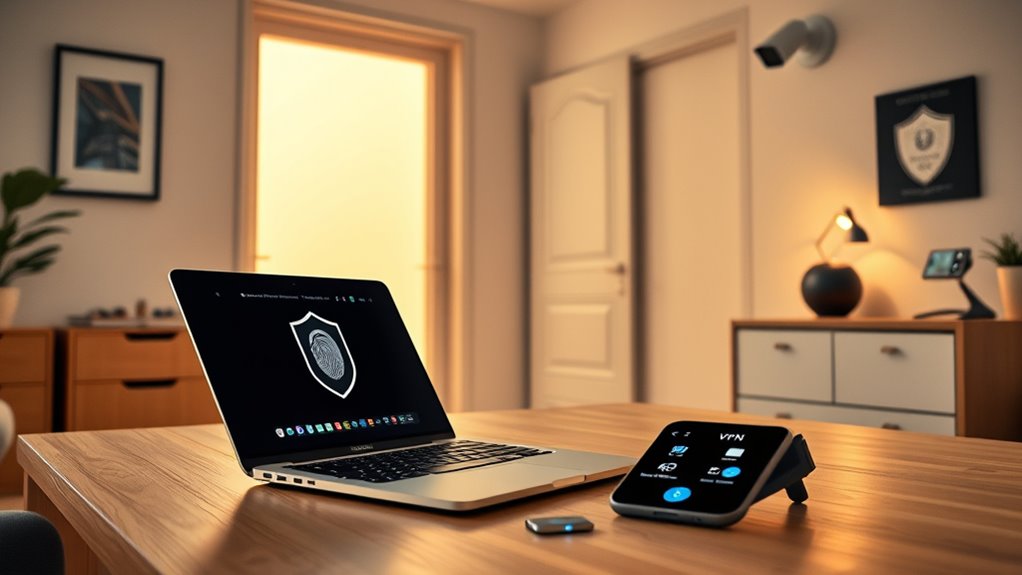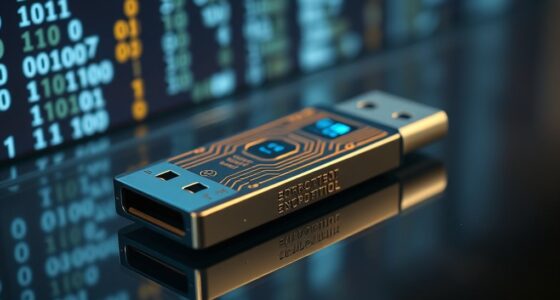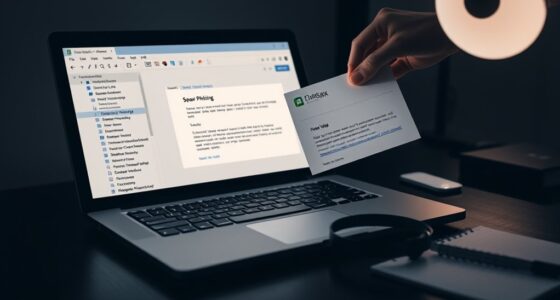When working remotely, it’s vital to use strong, secure VPN protocols like OpenVPN or WireGuard to protect your data. Always guarantee your devices have up-to-date endpoint security, including antivirus and multi-factor authentication. Avoid unsecured networks, activate VPN connections, and follow best cybersecurity habits to prevent breaches. Staying vigilant and adopting these practices creates a layered defense. If you continue exploring, you’ll learn more about how to keep your remote work secure.
Key Takeaways
- Use strong, up-to-date VPN protocols to secure remote connections and protect sensitive data.
- Deploy endpoint protection on all devices to monitor for threats and prevent unauthorized access.
- Follow best practices like enabling multi-factor authentication and regular software updates.
- Ensure organizational policies provide guidance on secure remote work and proper use of security tools.
- Maintain good digital hygiene through consistent security practices and staying informed about emerging cyber threats.

With remote work becoming increasingly common, safeguarding your digital security is more important than ever. As you access company data from various locations, you need to be vigilant about how your connections are protected. One of the most effective ways to secure your online activities is by using a reliable VPN. But not all VPNs are created equal. You should pay attention to VPN protocols, which are the underlying technologies that establish secure connections. Protocols like OpenVPN, WireGuard, and IKEv2 offer different trade-offs between speed and security. Choosing a VPN with strong, up-to-date protocols ensures your data remains encrypted and safe from prying eyes. This layer of security is especially essential when working over public Wi-Fi networks, where cybercriminals often lurk, waiting to intercept unprotected data.
Alongside VPN protocols, endpoint protection plays an indispensable role in your security setup. Your devices—laptops, smartphones, tablets—are often the first targets for cyber threats. Endpoint protection involves deploying exhaustive security measures directly on these devices to prevent malware, ransomware, and other malicious attacks. Think of it as having a digital shield that monitors for suspicious activity, blocks unauthorized access, and ensures your device’s security isn’t compromised. Regularly updating your software, using strong passwords, and enabling multi-factor authentication further bolster this protection. These steps minimize vulnerabilities that cybercriminals could exploit, especially when your device connects to different networks and systems. Additionally, understanding that necessary cookies are essential for site functionality can help you recognize which security features are fundamental and which are optional.
It’s also important to understand that secure remote work isn’t just about technology but also about habits. Never ignore security alerts or disable security features without understanding the consequences. When you’re working remotely, avoid using unsecured or personal devices for sensitive work unless they’re properly protected. Always verify the security of your network before connecting, and ensure your VPN is active whenever you’re accessing company resources. Combining strict endpoint protection with robust VPN protocols creates a layered defense, markedly reducing your risk of data breaches and cyberattacks.
Furthermore, your organization should provide guidance and tools to support these security measures. Keep your software updated, use encrypted communication channels, and participate in security training. Staying informed about emerging threats and best practices helps you recognize risks before they cause harm. By taking proactive steps and understanding the importance of VPN protocols and endpoint protection, you can confidently work remotely without compromising your company’s security. Remember, the effort you put into maintaining good digital hygiene directly impacts your safety and the integrity of your organization’s data.
Frequently Asked Questions
How Can I Secure My Home Wi-Fi Network Effectively?
To secure your home Wi-Fi network, start by updating your router settings with a strong, unique password. Enable Wi-Fi encryption, such as WPA3, to protect your data from unauthorized access. Regularly check for firmware updates on your router to patch security vulnerabilities. Disable remote management features, and consider hiding your network’s SSID. These steps help keep your connection secure and your personal information safe.
What Are the Best Practices for Managing Remote Work Device Access?
To manage remote work device access effectively, you should implement strict access control policies and guarantee device authentication. Use strong, unique passwords and multi-factor authentication for all devices. Regularly review and update access permissions, and only allow authorized devices to connect. Keep software and security patches current, and monitor device activity for unusual behavior. These practices help protect sensitive data and maintain secure remote operations.
How Do I Detect Phishing Attempts in Remote Communications?
To detect phishing attempts in remote communications, you should stay alert for email scams and fake links. Always scrutinize suspicious emails for spelling errors, strange sender addresses, or urgent language. Hover over links to see if they lead to legitimate sites, and avoid clicking on unknown attachments. Trust your instincts—if something feels off, verify the message through a separate communication channel before responding or providing any personal information.
What Steps Should I Take if I Suspect a Security Breach?
If you suspect a security breach, act quickly by initiating your incident response plan. Collect and document all relevant details without modifying or deleting anything. Notify your IT or security team immediately to ensure proper breach reporting. Follow their guidance for containment and investigation. Stay vigilant and avoid sharing sensitive information until the breach is resolved. Prompt action helps minimize damage and prevents further security issues.
How Can I Securely Share Sensitive Information Remotely?
When you need to securely share sensitive information remotely, start by using secure file sharing platforms that offer end-to-end encryption. This guarantees only you and the recipient can access the data. Avoid email for confidential files, and consider password-protecting documents. Always verify the recipient’s identity before sharing, and use strong, unique passwords for added security. These steps help protect your information from unauthorized access.
Conclusion
Now that you know the key security considerations, you can confidently combat cyber threats. By cultivating caution, controlling access, and consistently checking your defenses, you create a fortress of safety around your remote work world. Remember, vigilance is essential, and every vigilant step strengthens your security stance. Stay sharp, stay secure, and safeguard your space with steadfast strategies. Your security is your shield—shield it fiercely, and let your remote work remain safe and sound.









